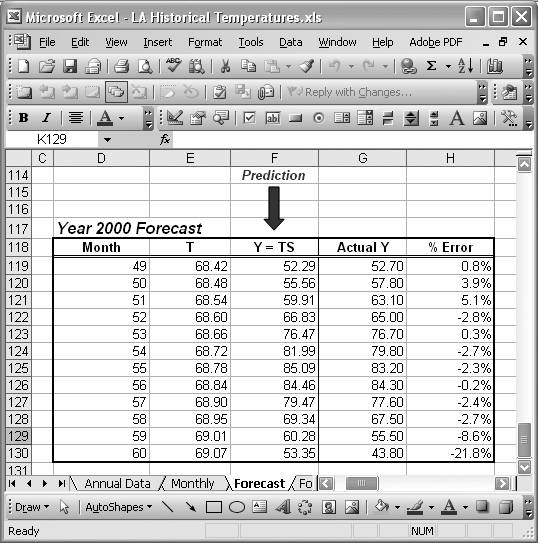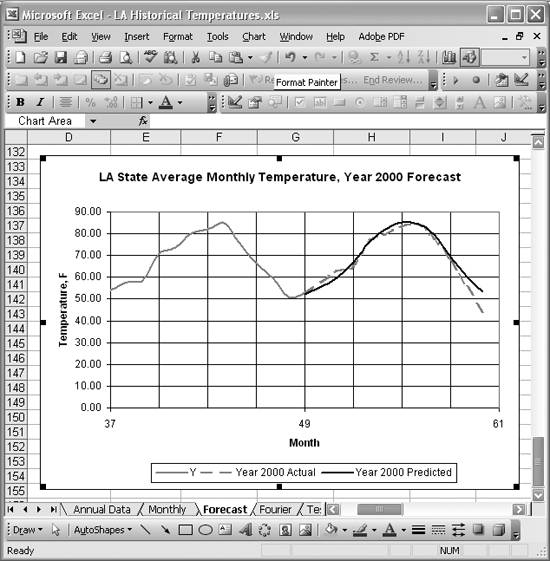Forecasting
Problem
You need to make a forecast of future values given historical values for a time series.
Solution
Excel does not provide built-in functionality for sophisticated forecasting . It does have a FORECAST spreadsheet function that sounds enticing; however, that merely uses a linear trendline and is unsuitable for time series that exhibit significant seasonal variability.
As an alternative, you could use the various moving average techniques to make near-term forecasts. Or you could use some higher-order regression equation (see Chapter 8) to make near-term predictions. Keep in mind that extrapolating too far beyond the extents of the original time series could result in significant errors.
If you have the resources, you could purchase one of the many Excel add-ins that offer sophisticated autoregressive moving average (ARMA) or neural network techniques. If you're so inclined, you can even program such techniques yourself in VBA.
In lieu of all these approaches, you can use standard spreadsheet techniques to make forecasts. I'll show you how by extending the techniques discussed in the previous several recipes.
Discussion
I'll again use the time series shown in Figure 6-23. Recall that this series consists of average monthly temperatures in Louisiana from January 1996 to December 1999. The task now is to make a forecast for the average monthly temperatures in the year 2000.
The brunt of this forecasting effort has already been covered in the previous recipes, in which I showed you how to decompose the time series into its various components using the model Y = TSI. (If you have not read the previous three recipes, you should do so now for relevant background discussion and calculations.)
In Recipe 6.8 I showed you how to compute the long-term trend component, T, for this example time series. Also, in Recipe 6.7 I showed you how to compute the seasonal indices for this example time series.
Now we'll put those results together to make a forecast for the year 2000. We can do so by computing Yf = TS. Here Yf represents the forecast temperature values. T represents the long-term trend, this time extended out over the year 2000. And S represents the seasonal indices as before.
|
So all you really need to do now is compute the long-term trend values for the year 2000 using the trend equation from the previous recipe. Then multiply these trend values by the seasonal index for each corresponding month to arrive at a prediction for each month in the year 2000. Figure 6-28 shows a spreadsheet I set up to perform these calculations.
Figure 6-28. Year 2000 forecast

The column labeled Month contains the months representing the year 2000 as an extension of the original series, in which December 1999 was month number 48. You need to number the months for the year 2000 this way because the trendline equation computed in the previous recipe is based on the original monthly series from months 1 to 48 and now we're extending that trend out over another 12 months.
Column T in Figure 6-28 shows the results of the forecast trend in the year 2000. The formulas in this column are of the form =0.0592*D119+65.521.
Column Y = TS contains the predicted average monthly temperatures for the year 2000. These are computed by multiplying each trend value for the year 2000 by the corresponding seasonal index for each corresponding month. For example, the predicted value for January 2000, cell F119, is computed using the formula =E119*Jan. Here again, I'm making use of the cell names I set up corresponding to each seasonal index computed in Recipe 6.7.
Figure 6-29 shows the predicted results compared to the actual average monthly temperatures on record for the year 2000.
Figure 6-29. Year 2000 forecast chart

As you can see, these predictions are fairly good. They won't get me a starring role as the local weatherman, but they're not bad for such a simple forecast model. The table in Figure 6-28 also contains computed %Error values, and you can see that errors are on the order of a few percent except for the months of November and December.
The forecasting technique shown in this recipe is by no means the only technique available to you. Time series forecasting is a huge field of study and there are many techniques and models available, many of which are tailored to specific kinds of time series. The examples discussed here serve to show how you can leverage Excel's standard functionality to perform predictions.
Using Excel
- Introduction
- Navigating the Interface
- Entering Data
- Setting Cell Data Types
- Selecting More Than a Single Cell
- Entering Formulas
- Exploring the R1C1 Cell Reference Style
- Referring to More Than a Single Cell
- Understanding Operator Precedence
- Using Exponents in Formulas
- Exploring Functions
- Formatting Your Spreadsheets
- Defining Custom Format Styles
- Leveraging Copy, Cut, Paste, and Paste Special
- Using Cell Names (Like Programming Variables)
- Validating Data
- Taking Advantage of Macros
- Adding Comments and Equation Notes
- Getting Help
Getting Acquainted with Visual Basic for Applications
- Introduction
- Navigating the VBA Editor
- Writing Functions and Subroutines
- Working with Data Types
- Defining Variables
- Defining Constants
- Using Arrays
- Commenting Code
- Spanning Long Statements over Multiple Lines
- Using Conditional Statements
- Using Loops
- Debugging VBA Code
- Exploring VBAs Built-in Functions
- Exploring Excel Objects
- Creating Your Own Objects in VBA
- VBA Help
Collecting and Cleaning Up Data
- Introduction
- Importing Data from Text Files
- Importing Data from Delimited Text Files
- Importing Data Using Drag-and-Drop
- Importing Data from Access Databases
- Importing Data from Web Pages
- Parsing Data
- Removing Weird Characters from Imported Text
- Converting Units
- Sorting Data
- Filtering Data
- Looking Up Values in Tables
- Retrieving Data from XML Files
Charting
- Introduction
- Creating Simple Charts
- Exploring Chart Styles
- Formatting Charts
- Customizing Chart Axes
- Setting Log or Semilog Scales
- Using Multiple Axes
- Changing the Type of an Existing Chart
- Combining Chart Types
- Building 3D Surface Plots
- Preparing Contour Plots
- Annotating Charts
- Saving Custom Chart Types
- Copying Charts to Word
- Recipe 4-14. Displaying Error Bars
Statistical Analysis
- Introduction
- Computing Summary Statistics
- Plotting Frequency Distributions
- Calculating Confidence Intervals
- Correlating Data
- Ranking and Percentiles
- Performing Statistical Tests
- Conducting ANOVA
- Generating Random Numbers
- Sampling Data
Time Series Analysis
- Introduction
- Plotting Time Series Data
- Adding Trendlines
- Computing Moving Averages
- Smoothing Data Using Weighted Averages
- Centering Data
- Detrending a Time Series
- Estimating Seasonal Indices
- Deseasonalization of a Time Series
- Forecasting
- Applying Discrete Fourier Transforms
Mathematical Functions
- Introduction
- Using Summation Functions
- Delving into Division
- Mastering Multiplication
- Exploring Exponential and Logarithmic Functions
- Using Trigonometry Functions
- Seeing Signs
- Getting to the Root of Things
- Rounding and Truncating Numbers
- Converting Between Number Systems
- Manipulating Matrices
- Building Support for Vectors
- Using Spreadsheet Functions in VBA Code
- Dealing with Complex Numbers
Curve Fitting and Regression
- Introduction
- Performing Linear Curve Fitting Using Excel Charts
- Constructing Your Own Linear Fit Using Spreadsheet Functions
- Using a Single Spreadsheet Function for Linear Curve Fitting
- Performing Multiple Linear Regression
- Generating Nonlinear Curve Fits Using Excel Charts
- Fitting Nonlinear Curves Using Solver
- Assessing Goodness of Fit
- Computing Confidence Intervals
Solving Equations
- Introduction
- Finding Roots Graphically
- Solving Nonlinear Equations Iteratively
- Automating Tedious Problems with VBA
- Solving Linear Systems
- Tackling Nonlinear Systems of Equations
- Using Classical Methods for Solving Equations
Numerical Integration and Differentiation
- Introduction
- Integrating a Definite Integral
- Implementing the Trapezoidal Rule in VBA
- Computing the Center of an Area Using Numerical Integration
- Calculating the Second Moment of an Area
- Dealing with Double Integrals
- Numerical Differentiation
Solving Ordinary Differential Equations
- Introduction
- Solving First-Order Initial Value Problems
- Applying the Runge-Kutta Method to Second-Order Initial Value Problems
- Tackling Coupled Equations
- Shooting Boundary Value Problems
Solving Partial Differential Equations
- Introduction
- Leveraging Excel to Directly Solve Finite Difference Equations
- Recruiting Solver to Iteratively Solve Finite Difference Equations
- Solving Initial Value Problems
- Using Excel to Help Solve Problems Formulated Using the Finite Element Method
Performing Optimization Analyses in Excel
- Introduction
- Using Excel for Traditional Linear Programming
- Exploring Resource Allocation Optimization Problems
- Getting More Realistic Results with Integer Constraints
- Tackling Troublesome Problems
- Optimizing Engineering Design Problems
- Understanding Solver Reports
- Programming a Genetic Algorithm for Optimization
Introduction to Financial Calculations
- Introduction
- Computing Present Value
- Calculating Future Value
- Figuring Out Required Rate of Return
- Doubling Your Money
- Determining Monthly Payments
- Considering Cash Flow Alternatives
- Achieving a Certain Future Value
- Assessing Net Present Worth
- Estimating Rate of Return
- Solving Inverse Problems
- Figuring a Break-Even Point
Index
EAN: 2147483647
Pages: 206

